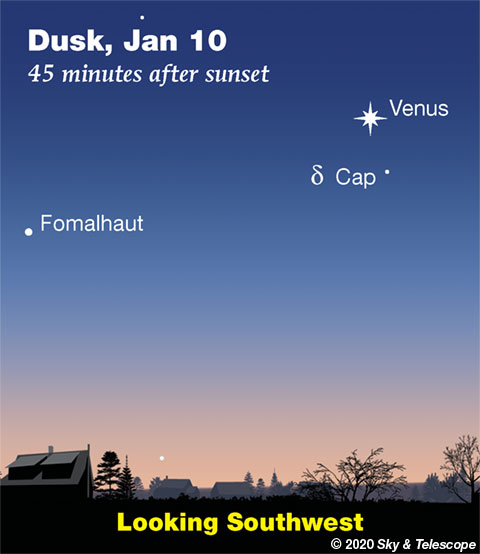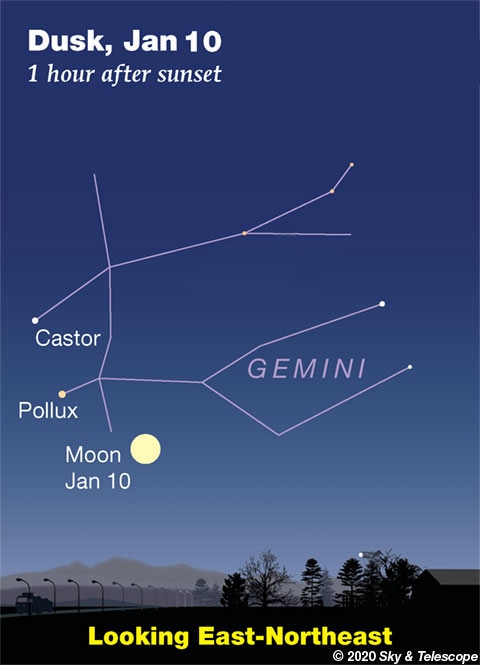

Friday, Jan. 10
• Full Moon (exact at 2:21 p.m. EST). This evening spot Pollux and Castor to the Moon's upper left, as shown below. Procyon shines farther to the Moon's lower right.
• Penumbral eclipse of the Moon for Europe, Africa, Asia, and Australia, as the Moon skims through the pale outer fringe of Earth's shadow. The eclipse is pretty deep as penumbral ones go: the Moon's edge misses the shadow's dark umbra by only about 10% of the Moon's diameter. Therefore the shading will be pretty obvious around the event's mid-time, 19:10 January 10th UT (GMT). The shading will be on the Moon's southern side. Full details. Live video stream (starts at 17:00 UT).
Saturday, Jan. 11
• Here it is the coldest very bottom of the year, but the Summer Star, Vega, still hangs in there. Look for it twinkling in the northwest during and shortly after nightfall. The farther north you are the higher it will be. If you're north of latitude 51° (Calgary, central Ontario and Quebec, London, Berlin), Vega is actually circumpolar. But if you're too far south, it's already gone.
Sunday, Jan. 12
• The waning gibbous Moon rises in the east about an hour after dark. As it climbs, watch below it for Regulus to creep up in its wake. For North America they're about 6° or 7° apart.
Monday, Jan. 13
• Dimmed Betelgeuse. The red supergiant Betelgeuse marking Orion's shoulder has always been slightly variable, but lately it has been in an unusually low dip: As of January 9th it was around visual magnitude +1.4 instead of its more typical +0.5. That's actually fainter than Aldebaran, with which it's often compared, magnitude +0.9. Where do you judge it? See Bob King's What’s Up With Betelgeuse?
And no, this does not mean Betelgeuse is about to go supernova, despite the overinflated hype going around (friends and relatives keep asking me). Yes, it's nearing the end of its life — but on an astronomical timescale! Expect to wait something like 100,000 years.
Tuesday, Jan. 14
• Sirius twinkles brightly after dinnertime below Orion in the southeast. Around 8 or 9 p.m., depending on your location, Sirius shines precisely below fiery Betelgeuse in Orion's shoulder. How accurately can you time this event for your location, perhaps using the vertical edge of a building? Of the two, Sirius leads early in the evening; Betelgeuse leads later.
Wednesday, Jan. 15
• With the Moon gone from the early-evening sky, explore the stars and asterisms around the dim base of Orion's Club — including little NGC 2169, the "37 Cluster" — using Matt Wedel's Binocular Highlight map and column in the January Sky & Telescope, page 43.
With a telescope, tour Jerry Oltion's selection of winter's big, bright and beautifuls starting on page 58, and explore the depths of Auriga with Deep-Sky Wonders starting on page 54.
Got a big scope and a very dark sky? Go deep-fishing in the Pisces Galaxy Cloud — 230 million light-years deep — starting on page 58.
Thursday, Jan. 16
• Zero-magnitude Capella, very high in the east after dinnertime, and zero-magnitude Rigel, in Orion's foot, have almost the same right ascension. This means they cross your sky’s meridian at almost exactly the same time: around 9 or 10 p.m. now, depending on how far east or west you live in your time zone. (Capella goes exactly through your zenith if you're at latitude 46°N: Portland, Oregon; Montreal; central France.) So whenever Capella passes highest, Rigel always marks true south over your landscape, and vice versa.
• Algol shines at its minimum brightness, magnitude 3.4 instead of its usual 2.1, for about two hours centered on 10:36 p.m. EST. Algol takes several additional hours to fade beforehand and to rebrighten after. At any random time you glance up at Algol, you have only a 1-in-30 chance of catching it at least 1 magnitude fainter than normal. So here's your opportunity. Comparison-star chart.
Friday, Jan. 17
• Last-quarter Moon (exact at 7:58 a.m. on this date EST). By the time it rises tonight around 1 a.m., it will have waned slightly past exact last quarter. It'll be at the dim feet of Virgo then, with Spica to its upper right and bright Arcturus higher to its upper left.
Saturday, Jan. 18
• Is your sky dark enough for you to see the winter Milky Way? In mid-evening now it runs vertically up and across the zenith: from Canis Major low in the southeast, up between Orion and Gemini, through Auriga and Perseus almost straight overhead, and down through Cassiopeia, Cepheus, and Cygnus to the northwest horizon.
________________________
Want to become a better astronomer? Learn your way around the constellations. They're the key to locating everything fainter and deeper to hunt with binoculars or a telescope.
This is an outdoor nature hobby, cold or not! For an easy-to-use constellation guide covering the whole evening sky, use the big monthly map in the center of each issue of Sky & Telescope, the essential guide to astronomy.

Once you get a telescope, to put it to good use you'll need a detailed, large-scale sky atlas (set of charts). The basic standard is the Pocket Sky Atlas (in either the original or Jumbo Edition), which shows stars to magnitude 7.6.
Next up is the larger and deeper Sky Atlas 2000.0, plotting stars to magnitude 8.5; nearly three times as many. The next up, once you know your way around, are the even larger Interstellarum atlas (stars to magnitude 9.5) and Uranometria 2000.0 (stars to magnitude 9.75). And read how to use sky charts with a telescope.
You'll also want a good deep-sky guidebook, such as Sue French's Deep-Sky Wonders collection (which includes its own charts), Sky Atlas 2000.0 Companion by Strong and Sinnott, or the bigger Night Sky Observer's Guide by Kepple and Sanner.
Can a computerized telescope replace charts? Not for beginners, I don't think, and not on mounts and tripods that are less than top-quality mechanically (meaning heavy and expensive). And as Terence Dickinson and Alan Dyer say in their Backyard Astronomer's Guide, "A full appreciation of the universe cannot come without developing the skills to find things in the sky and understanding how the sky works. This knowledge comes only by spending time under the stars with star maps in hand."
This Week's Planet Roundup
Mercury is out of sight in the glare of the Sun.
Venus (magnitude –4.0, between Capricornus and Aquarius) dominates the southwest during and after twilight. It will shine as the grand "Evening Star" at dusk all winter and into the spring. In a telescope Venus still appears small (14 arcseconds) and gibbous (78% sunlit), but it will enlarge in size and wane in phase for the next 4 months.
Mars (magnitude +1.6, passing the head of Scorpius) glows in the southeast before and during early dawn, not very high. It's a very tiny 4 arcseconds in diameter.
Below or lower right of it twinkles Mars-colored Antares, which at magnitude 1.1 is noticeably brighter than Mars now (not counting the effects of atmospheric extinction).
Jupiter is buried deep in the glow of sunrise.
Saturn is out of sight in conjunction with the Sun.
Uranus (magnitude 5.8, in southern Aries) and Neptune (magnitude 7.9, in eastern Aquarius) stand high in the south and much lower in the southwest, respectively, right after dark. Use our finder charts for Uranus and Neptune.
All descriptions that relate to your horizon — including the words up, down, right, and left — are written for the world's mid-northern latitudes. Descriptions that also depend on longitude (mainly Moon positions) are for North America.
Eastern Standard Time (EST) is Universal Time (UT, UTC, GMT, or Z time) minus 5 hours.
![]() Audio sky tour. Out under the evening sky with your earbuds in place, listen to Kelly Beatty's monthly podcast tour of the heavens above. It's free.
Audio sky tour. Out under the evening sky with your earbuds in place, listen to Kelly Beatty's monthly podcast tour of the heavens above. It's free.
 2
2








Comments
Pencil BFB
January 11, 2020 at 10:48 am
BUT! If you live south of 15°N (Goa, India; Manila; and the southernmost parts of Mexico), whenever Rigel is highest, Capella tells you rough true north. This is because Rigel goes nearer the zenith.
You must be logged in to post a comment.
Pencil BFB
January 11, 2020 at 10:52 am
Well, that is IF you do not go farther south than 44°S (Tasmania; Christchurch, New Zealand) because Capella will not be visible from there.
You must be logged in to post a comment.
You must be logged in to post a comment.